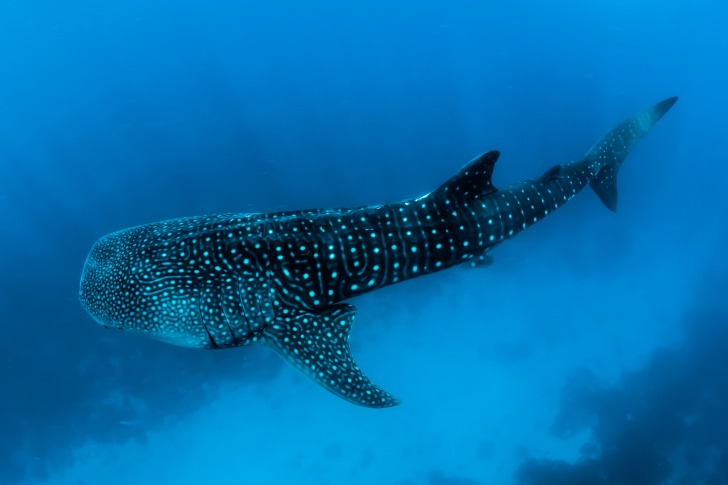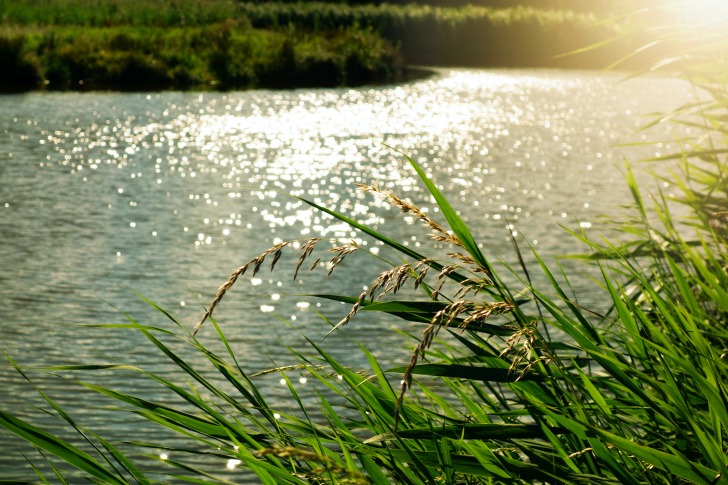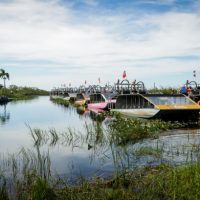The Indian River is found in Florida.
The stretch from the Ponce de Leon inlet in Volusia County southward.
The Indian River consists of 121 miles of brackish water.
The river forms part of the Indian River Lagoon system.
This system in turn forms part of the Atlantic Intracoastal Waterway.
The river is home to a wide range of animals, both land and aquatic.
There are pelicans, dolphins, sea turtles, and a wide range of sea life that call the river home.
Contents
So… Are There Sharks in the Indian River?
The most important factor to consider when wondering about the shark life in this river is whether the river is a freshwater or saltwater river, as this will determine if there are sharks in the river.
The reality is that the river is not really a river.
It is more of an estuary and a lagoon.
In this body of water, salt water from the Atlantic Ocean, and freshwater from inland meet to form brackish water.
Saltwater enters the body of water through various inlets from the ocean, such as the Sebastian Inlet.
Freshwater spills into the body of water through tributaries on the mainland.
The river flows in different directions.
Some days the river flows north, while on other days the river flows south.
Or, it may even be stagnant on some days.
The average depth of the water is only four feet deep.
The temperature of the water ranges according to the seasons.
During summer, the water is a warm 73°F to 77°F, while in the winter, the water cools down dramatically to 36°F to 43°F.
It’s common knowledge that most sharks live in the ocean.
They prefer saltwater as they need it to live and thrive.
And, we know that the Indian River is brackish water.
So is there a possibility that there might be sharks in brackish water?
Absolutely.
Some sharks have adapted to swimming in fresh and brackish water.
Two of the shark species that have been spotted here are the Great White Shark and the bull shark.
These are two of the most dangerous sharks known to man.
They are exceptionally dangerous and very aggressive to humans.
They often swim upstream in fresh and brackish water bodies.
You’re more likely to spot these sharks during the summer when the water temperature is in the range that is most suited to sharks.
These apex predators prefer warmer waters with temperatures around 72°F.
As mentioned previously, the warmer water and weather during the summer in Florida make the water conditions ideal for these sharks to swim in.
There are two main species of shark found in the Indian River: the bull shark and the Great White Shark.
The bull shark (Carcharhinus leucas)
These sharks can be found throughout the world in warm, shallow ocean waters.
They live in saltwater but their bodies have adapted to life in fresh and brackish water as well.
Their diet is mainly made up of fish.
They do not actively hunt humans, but they are known to be some of the most dangerous apex predators on the planet and account for the majority of shark attacks worldwide.
They hunt both during the day and at night.
These sharks have developed special adaptations which allow them to swim in freshwater.
These include glands near their tails and the way their kidneys function.
It is not known how or why they have developed these abilities, as scientists are still studying this phenomenon.
The Great White Shark (Carcharodon carcharias)
The Great White shark is another one of the most dangerous sharks in the world.
These sharks are known for attacking humans.
They can grow to be 20 feet in length and weigh up to 6000 pounds.
These sharks can easily live to be around 30 years of age.
They play a very important role in the health of the ocean and the ecosystem as the apex predators of the ocean.
They keep sea lion and elephant seal numbers in balance by eating this type of prey.
The Great White shark has serrated bladelike teeth with a total of 28 teeth in its upper jaw and 26 teeth in its lower jaw.
The females may give birth to up to ten pups per litter.
Is it Safe to Swim in the Indian River?
Many people come to the Indian River on a boat, jet ski, swim, or paddleboard.
The water in the Indian River generally looks safe and clear but there are some things that need to be noted.
There are no water quality checks in the Indian River like there are in the oceans in Florida.
Residents are warned to be careful before plunging into the water. Bacteria levels can easily spike after heavy rain.
Then, of course, there’s the threat of sharks that are present in the water.
These are two of the most dangerous sharks known to man and they are both present in the Indian River.
Swimmers are advised to exercise extreme caution when swimming in this river.
Swimmers should avoid swimming in the water when sharks are known to be feeding, which is at dawn and dusk.
Apart from these threats, swimming in the river seems perfectly fine, provided that caution is exercised at all times.

Interesting Shark Facts in the Indian River
Here are some very interesting shark facts about the sharks found in the Indian River and other sharks as well.
Sharks do not have bones in their bodies like other fish.
Their skeletons are actually quite delicate.
A shark’s skeleton is made of cartilage and connective tissue.
Having a skeleton made of cartilage and connective tissue actually helps the shark to be more flexible in the water.
This type of structure assists the shark when they are hunting prey.
The sharks swim very fast in the ocean and make sudden turns as they chase their prey.
This type of structure can help the sharks to quickly turn and move swiftly in the water.
Their bodies are also much lighter as a result.
Sharks never sleep.
They are unable to sleep as they need to keep moving to stay alive.
So, what they do is go into a state of semi-consciousness where they float in the water and slowly swim from time to time.
They do just enough to keep them alive.
So, while you may think that a shark is lazy or lethargic, what they are actually doing is getting a bit of shut-eye.
Here is another very interesting fact about certain species of female sharks: they are asexual.
Some female sharks are able to reproduce independently without the need to be fertilized by a male shark.
What this means, essentially, is that the female shark is able to fertilize the eggs herself or does not require fertilization in order to grow fully formed baby sharks.
There are, however, some drawbacks to this type of reproduction.
There is less genetic diversity, which means that these sharks are more prone to diseases.
There are only three different shark species that are responsible for the most attacks on humans.
They are the Great White shark, the bull shark, and the tiger shark.
These sharks are present all over the world, but most attacks on humans by these sharks have occurred in the United States.
In addition, the most fatal shark attacks have occurred in the US.
Sharks are much more buoyant in saltwater and are able to swim better in saltwater.
They do not have a swim bladder like most other fish that helps them stay afloat.
This is an organ found in most bony fish that is filled with gas and helps the fish float.
Furthermore, according to the Smithsonian, sharks do have large oil-filled livers, though, that help them to swim in salt water.
Saltwater sharks typically prefer saltwater because they need salt from the saltwater to stay alive.
Sharks must retain the salt in their bodies and are often saltier than the water they swim in.
Without the salt, their cells would rapture, would start to bloat, and would eventually die.
In freshwater, though, sharks are much less buoyant.
There are sharks that have adapted to freshwater.
They have exceptionally large oil-filled livers that help them stay afloat in fresh water.
They also have special gills and kidney functions to help with the reduced amount of salt in the water.
There are sharks, like the bull shark and the Great White shark that have adapted to swimming in fresh and brackish water.
They live in the ocean in saltwater but they are able to swim in fresh and brackish waters as well.
3 Safety Tips for Swiming in Shark-infested Waters
- Avoid shark-infested water at dawn, dusk, or at night. These are the times that sharks are known to be feeding. Swimming in shark-infested waters during this time poses a great risk to your overall safety. Avoid any body of water that is known to host any sharks, especially sharks that are known to be dangerous to humans.
- Never go swimming alone. Always swim in a group. And, when you go into the water, be sure not to be at the edge of the group as this is the most dangerous spot to be in. Be sure to swim in areas that are designated for swimming and always swim where there is a lifeguard present.
- Don’t splash too much in the water. The sharks may easily mistake you for a seal or other type of prey, as this is the behavior demonstrated by the prey that the sharks hunt.
Summary
There are a few species of sharks that are present in the Indian River.
Although the river is brackish, there are still some sharks that swim in the river that have adapted to living in fresh and salt water, like the bull shark and the Great White shark.
The Indian River is known to be fairly safe for swimmers and has not proven to be much of a concern when it comes to bacteria levels, but swimmers should still exercise extreme caution when swimming in the river as it is home to two of the deadliest apex predators in the world: the bull shark and the Great White shark.
Frequently Asked Questions
Have there been any fatal shark attacks in the Indian River?
No, there have been no reported fatal shark attacks in the Indian River.
Are there seals in the Indian River?
No.
There are no seals in Florida as harbor seals do not strand in the state.
When is the most shark activity in the Indian River?
Sharks are present in the river during the summer from April through to October, when the temperature of the river is ideal for the shark.












In my opinion, while it is important to be cautious and aware of the potential presence of sharks in the Indian River, it should not deter people from enjoying this beautiful body of water and the diverse range of animals that call it home.